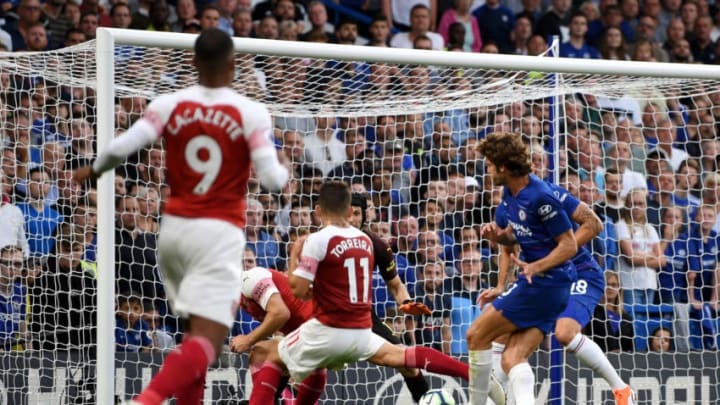Chelsea dominated possession for 90 minutes against Newcastle and then against Bournemouth, but they held the lead for only 28 minutes between the two games. The Blues have yet to convert prolonged control of the ball into control of the game.
Chelsea have yet to trail in the four games of this season. In each of the first two games the Blues scored two goals in the first half followed by a third just after the 80′. Against Huddersfield the third goal was a bonus. But against Arsenal and then in the next two games, the Blues scored their game winner after the 70′.
In those games against Newcastle and Bournemouth, the Blues did not open the scoring until the final 20 minutes. Maurizio Sarri’s men dominated possession in each. They set a few empty records for possession and passing at Newcastle but could not turn anything into a goal until Marcos Alonso drew a penalty and Eden Hazard converted. Chelsea had slightly less of the ball against Bournemouth – still well more than in the first two games – and still needed until the final span to turn control of the game to control over the result.
Chelsea’s possession in the final 30 minutes of both games was significantly lower than in the first two 30-minute spans. Their lowest half-hour of possession against Huddersfield and Arsenal was in the middle of the game.
Over the opening four games of the season, the Blues’ expected goal (xG) tally per 30 minutes increased as the game goes on. Despite having the most possession in the first 30 minutes, that is where they have the lowest xG. As possession increases over the next hour, xG increases markedly.
| 1'-30' | 31'-60' | 61'-FT | |
|---|---|---|---|
| Possession vs. Huddersfield | 64.8 | 59.5 | 63.4 |
| Poss. vs Arsenal | 63.7 | 55.3 | 68.5 |
| Poss. vs. Newcastle | 81.7 | 83.6 | 77.5 |
| Poss. vs. Bournemouth | 77.6 | 75.1 | 64.6 |
| xG (through 4 games) | 1.04 | 2.79 | 2.82 |
Chelsea are not yet at the point in their Sarrismo development where they can psychologically attrite their opposition into committing a mistake. Pep Guardiola’s Barcelona used their intense possession, passing and probing to break down a defence mentally as well as tactically. Withstanding wave after wave of Barcelona’s attacks eventually took its toll on most teams.
The Blues have the possession and the passing, but they are scarcely probing and even more rarely penetrating the opposition. Newcastle did not give an inch on defence for 90 minutes, and Chelsea needed two fortuitous circumstances to score their two goals. Similarly, Bournemouth’s change in the final 30 minutes was due to something intrinsic on their side. It was not anything Chelsea did to them.
Bournemouth and Newcastle both defended with a compact block of two lines. Newcastle only left Salomon Rondon higher up the pitch in their 5-4-1, while the Cherries fell back more into a 4-4-2. Bournemouth, though, positioned their defence about 10-15 yards higher than Newcastle.
While Newcastle scarcely ventured out of their position and shape – booting the ball up-field rather than risking passes when they took possession – Bournemouth opened up as the game went on. They may have felt some (over)confidence at holding Chelsea scoreless through 60 minutes, and started looking for an opportunity to nip a goal against the run of play. Or they may have begun to fatigue mentally and physically, no longer able to maintain the intensity and discipline that is much more ingrained in Rafael Benitez’s side. Either way, they enjoyed more time on the ball in the final 30 minutes, but at the cost of allowing two goals.
If an opponent are not interested in pursuing and then maintaining possession, they may be luring Chelsea into the trap of possession without purpose. Right now, the Blues are not giving them much to fear.
This tactic does not have to be limited to lower-half sides. An open game – the kind one would expect from two top-half teams – works to Chelsea’s advantage by creating the space necessary for them to execute their current level of Sarrismo. A team that can pivot from being a possession-oriented team to a counter-attacking team can draw Chelsea into their hypnotic Jorginho-centric passing, let the Blues’ centre-backs make their way forward, let Marcos Alonso park himself near the box and then strike through open spaces on a counter-attack. Think Leicester City 2015/16, or Tottenham present day (not that I’m comparing Tottenham to any team who has ever won something).
Chelsea will face a new challenge the first time they fall behind and have to chase the game. So far they have been able to play on their own tempo by scoring first, whether that happens after 7 or 70 minutes. This permits a certain level of patience and casualness, the sense that they can wait until the absolute most perfect moment and, if they don’t have such a moment, don’t worry they have time.
But the recent trend of late opening goals invites the day when the Blues are on someone else’s terms and must operate with a sense of urgency. That will be the next waypoint on this new tactical road.
